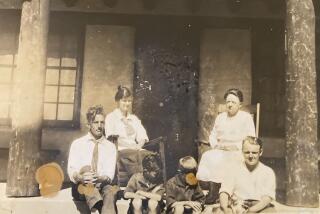Eskimo Son of Explorer Peary Has Few Regrets
- Share via
QAANAAQ, Greenland — Kale Peary, after 80 years at the icy fringe of the inhabited world, has lost all memory of his famous American father. But this old hunter will never forget the dogs that eased his hard life.
“My sled dogs were my greatest honor,” Robert E. Peary’s half-Eskimo son told a visitor. “They made my hunting life successful, and I will always be grateful.”
Outside, in Qaanaaq’s muddy lanes, tethered teams of huskies howled in the 24-hour summer sunlight, as they have for generations in this remote corner of northwestern Greenland.
Qaanaaq, together with its outlying hamlets, is the northernmost continuously inhabited area on Earth, just 850 miles from the North Pole. American explorer Peary came through here in 1906 in his quest--eventually successful--to be the first to reach the Pole. He left behind a son born of a local Polar Eskimo woman, Aleqasina.
Reunion in U.S.
The parentage of the younger Peary, whose first name is pronounced “Kah’-lee,” was always known to the Eskimos. Visiting French ethnologist Jean Malaurie reported Kale’s existence to the outside world in the 1950s, and Harvard University scholar S. Allen Counter made him more widely known through an American magazine article last year.
This May, Kale Peary and Anaukaq Henson, also 80, the half-Eskimo son of Robert Peary’s American assistant, Matthew Henson, traveled to the United States for a reunion with American relatives. Henson, who was suffering from cancer, died soon after returning to Greenland.
It was Kale Peary’s first trip beyond the frigid hunting grounds of the Polar Eskimos, and he was impressed. Of New York City, he said: “I have heard in church how God made the world. But I was amazed that man could do such things.”
He clearly was pleased, however, to return to his homeland of boundless ice and crystalline air.
Might Be Bored
“Maybe if I tried to live in America it would be boring,” he told a visiting reporter, speaking through an interpreter. “I was always very active . . . used to a lot of space, with no rules about what you can do and cannot do.”
The great explorer’s son is 5-foot-4, built like a block, with tough, stubby hands, steel gray hair and a direct, honest gaze. His face is strikingly Anglo-Saxon in appearance, unusual in this solidly Eskimo part of Greenland.
He recently settled into his daughter Paulina’s home in Qaanaaq, leaving his wife to tend their old house in tiny Qeqertat, 40 miles east of here. He is waiting to move into another home in this settlement of 500 people, a hillside hamlet that perches above the icebergs of Inglefield Fiord.
“It’s too cold in our house, and I’m getting old,” said Peary, father of four surviving children and “I don’t know how many” grandchildren.
Doesn’t Remember Father
He cannot remember his father, but he said that his mother, who died in the 1920s, told him he used to play at the U.S. Navy commander’s knee when he was a toddler in sealskin clothes.
The American explorer left the area after his 1909 polar conquest, and Kale was reared by a succession of Eskimo stepfathers, who taught him the ancient skills of the northern hunt. For decades, he led a semi-nomadic life in sod houses and tents, driving dog sleds and paddling kayaks, on the lookout for seal, walrus and narwhal.
At times life was so hard that Peary’s abandoned son wore dog-skin clothes, a badge of poverty among Eskimos. It was also often dangerous. He told, for example, of the time he was attacked by an enraged walrus and narrowly escaped with his life.
In his classic 1954 book “The Last Kings of Thule,” Malaurie attested to Kale Peary’s reputation as a superb hunter, a life the aged man gave up only three years ago. Asked today about his encounters with polar bears, Peary smiles mischievously and says, “I got so many I lost track.”
Biggest Regret
His biggest regret, he told his American visitor, is that he never learned another language. His Polar Eskimo tongue is spoken by fewer than 1,000 people.
Does he feel his illustrious father, who died in 1920, should have cared more for him--perhaps taken him home to America?
The old hunter, whose few keepsakes include faded magazine photos of the great Peary, pondered the question for a long moment.
“I lived only by hunting and for hunting, and not by looking for help,” he said. “I watched out for my dogs. I used my eyes, not my ears. I wasn’t listening for help from my father. . . . I enjoyed my old life.”
More to Read
Sign up for Essential California
The most important California stories and recommendations in your inbox every morning.
You may occasionally receive promotional content from the Los Angeles Times.












